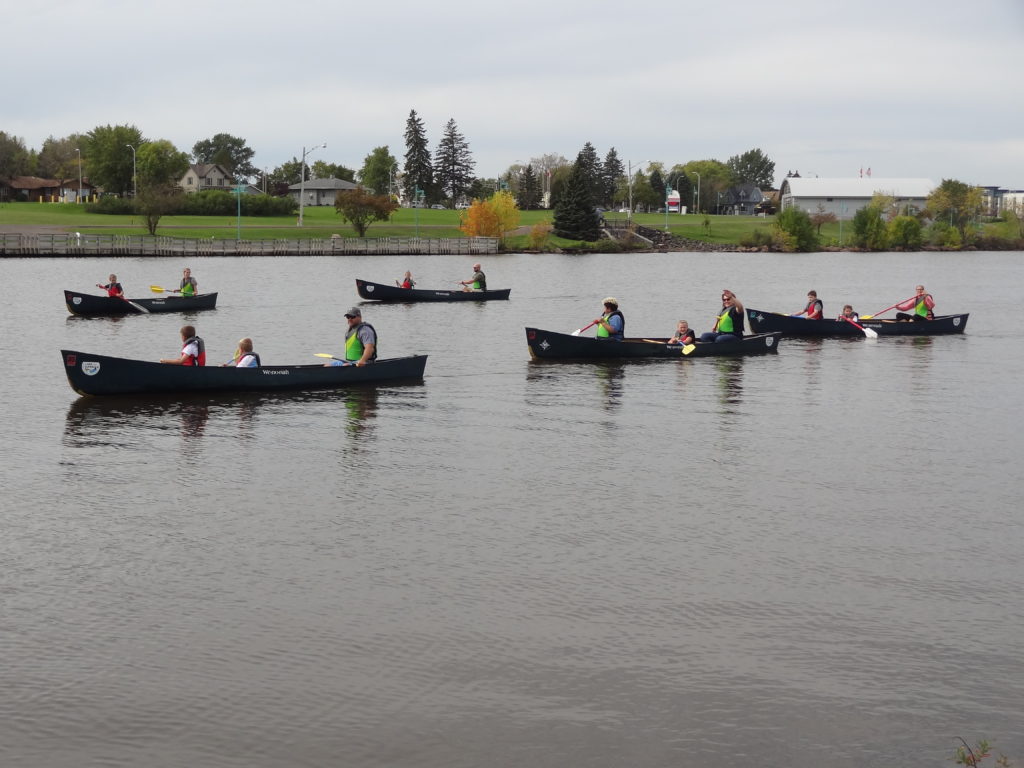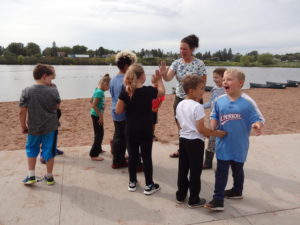
Children participating in the Rivers2Lake Education Program canoe in the St. Louis River Estuary. For many, this was their first time canoeing. Image by Marie Zhuikov, Wisconsin Sea Grant.
Second-graders from Great Lakes Elementary canoe through a large culvert and squeal. Echoes of their delight reverberate across the St. Louis River bay on Barker’s Island on a bright fall day.
In most classrooms, teachers would “shush” this kind of behavior. Not today. Not here.
These children are part of the Rivers2Lake Education Program, run by the Lake Superior National Estuarine Research Reserve. Education Coordinator Deanna Erickson said she encourages such behavior. “We’re working on making canoeing slow-paced and fun. We recognize that distance is not the objective for the kids. Staying upright is the objective, and liking it.”
Rivers2Lake is showing children from school districts in Bayfield, Ashland and the South Shore of Lake Superior how nature can be a classroom. The program is also building a community of educators who are dedicated to sharing the Great Lakes with their students – all with funding help from Wisconsin Sea Grant for two years.
Erickson began the program seven years ago, using long-term mentoring as professional development for teachers to help them gain confidence in using outdoors learning with their classes.
“We’re building a sense of place,” said Erickson. “We’re helping students and teachers feel a sense of engagement in their learning and feel excited about it. We’re helping them build STEM skills through hands-on experience that connects with the science community here on the estuary.”
The teachers of the canoeing second-graders began their participation in the program a few months earlier, during summer. Twelve teachers took part in a weeklong Rivers2Lake Summer Institute where they learned more about the St. Louis River and Estuary. They traveled to the upper reaches of the river, trapping water bugs in nets, learning how to test water quality and developing a relationship with the river. The teachers worked their way down to Lake Superior, comparing water quality results with their findings from other parts of the river.
After the institute, Reserve staff met with the teachers individually. Erickson explained the process. “We sit down and learn what they’re doing in their classrooms – what their needs with their kids are. Then we come up with ideas that relate to the Lake Superior Watershed. Then we go outside with the kids and do stuff.”
The children on Barker’s Island arrived at 10 a.m. They explored the Reserve’s Estuarium, which is a learning facility about the St. Louis River. They moved to the dock behind the Estuarium to test the river water for temperature and turbidity (cloudiness). Next, they honed their canoe skills (accompanied by an adult) by paddling in the bay along the island, culminating in a trip through the culvert and landing at the newly renovated Barker’s Island Beach.

Deanna Erickson, education coordinator with the Lake Superior Reserve, high-fives second-graders on their canoeing skills. Image by Marie Zhuikov, Wisconsin Sea Grant.
After landing, Erickson congratulated them. “You all did a great job! I am super impressed. You were safe, you had fun, and stayed balanced, which is awesome.” She gathered the children together for a group cheer. “One, two, three, canoeing!”
The smiles on the children’s faces attest to the connections they are making to their environment. More formal evaluation of the Rivers2Lake Program supports that, as well. Erickson worked with a professor at the University of Minnesota Duluth to compare classrooms enrolled in Rivers2Lake with those not enrolled. “There was a significant difference in academic engagement between control classrooms and Rivers2Lake classrooms,” Erickson said. “The Rivers2Lake kids really wanted to be in school more, which translates into more academic engagement.”
Teachers are evaluated every year. Erickson said they show progress in their skills and confidence using outdoor- and place-based learning. One-on-one visits by Rivers2Lake staff twice per month throughout the school year help with that.
The Sea Grant funding covers costs for two staff members who help run the program. Other funding comes from the Reserve and a grant from the National Oceanic and Atmospheric Administration’s Bay Watershed Education Training Program, which is routed through the Great Lakes Restoration Initiative.
Once the field trip is over at 2 p.m., Erickson said the kids were “Really tired and kind of dragging. In my canoe, the little guy in the front, who definitely had a lot of energy, got really quiet. He sighed and said, ‘This is so relaxing.’ I just thought that was really sweet. That’s exactly what you want a kid’s first canoe experience to be.”





